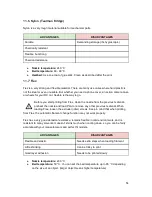
11 Materials
Temperatures and the heatbed treatment before a print according to a specific material.
11.1 ABS
ABS is a very strong and versatile material with
great thermal resistance
. It’s suitable for
both indoor and outdoor use. ABS is a thermoplastic polymer; that means that just like PLA,
it can be melted and crystallized multiple times without degrading too much. ABS, however,
melts at a higher temperature than PLA. Higher melting temperature gives ABS great
thermal resistance; your prints won’t show signs of deformation
up to 98 °C
.
ABS includes high wear-resistance synthetic rubber, which makes it
very strong and
impact resistant
. And last but not least, it’s
soluble in acetone
! This makes it really easy to
not only connect multiple parts together, but also allows you to
smooth prints
with acetone
vapors. You still have to be careful when handling acetone, but it’s not anywhere near as
dangerous as PLA solvents, for example.
The best use of ABS is for architectural models, concept models, spare parts (car
interior, gears, phone cases), etc.
On the other hand, thermal contraction is where ABS makes it really hard to successfully
print something. And that’s especially true when printing anything larger. Even with the
heatbed at 100 °C, your part may start lifting from the build plate and warp. This, and the
unpleasant smell
of ABS, is why you should consider getting an enclosure for your printer
when printing with ABS. Or at least place the printer in a warm room.
If you need to use your print outside, or just need your print to be stronger, give ABS a shot.
After all, it’s what
LEGO
is made of.
ADVANTAGES
DISADVANTAGES
High impact and heat resistance
Bad smell
Strong and versatile
Worse resolution
Soluble in acetone (easy post-processing)
Needs warm room or enclosure
Can be vapor smoothed
● Nozzle temperature:
255
°C
● Bed temperature:
100 °C. You can set the bed temperature between 80 to 110 °C
depending the size of an object (larger object means higher temperature)
● Heatbed:
Make sure the surface is clean as described in
6.2.2 Flexible steel sheet
surface preparation
chapter
50
Summary of Contents for i3 MK2.5
Page 1: ......
Page 64: ...Pict 40 Nozzle change 64 ...
















































